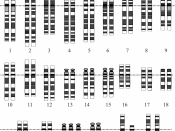Down Syndrome According to Dr. Stephen Trumble there is evidence in ancient art of people with trisomy 21 being part of the human race for thousands of years. In 1866 Dr. John Langdon Down, director of an asylum in Surrey, England, was the first to notice and describe the facial similarities of people in his group of mentally retarded patients. He published and essay used the word "Mongol"� to describe them because of their supposed likeness to the people from Mongolia. During this time people didn't know the cause of Down Syndrome, in the early part of the twentieth century people thought many things could be the cause. In 1959 two scientists, Jacobs and Lejeune, working separately, found the cause to be trisomy 21.
This trisomy involves genetics. All people have cells in their bodies, and these cells carry the individual set of traits that determine many things like characteristics, growth, and development.
All of these traits are controlled by genes, which are located in chromosomes. There are forty-six chromosomes in a human cell, which are arranged in twenty-three pairs. During conception a baby receives twenty-three from the mother and twenty-three from the father which is how forty-six end up in a human cell. With Down Syndrome there is a problem in cell formation, which causes an extra chromosome to be produced. This gives the baby forty-seven chromosomes instead of forty-six.
There are three different types of Down Syndrome. The first is trisomy 21, which makes up approximately ninety five percent of Down Syndrome patients. This occurs when one cell has one twenty-first chromosome and the other has two twenty-first chromosomes. The result is fertilized egg with three twenty-one chromosomes. Another type of Down Syndrome is translocation. Translocation occurs when and extra twenty- one chromosome has translocated on...


